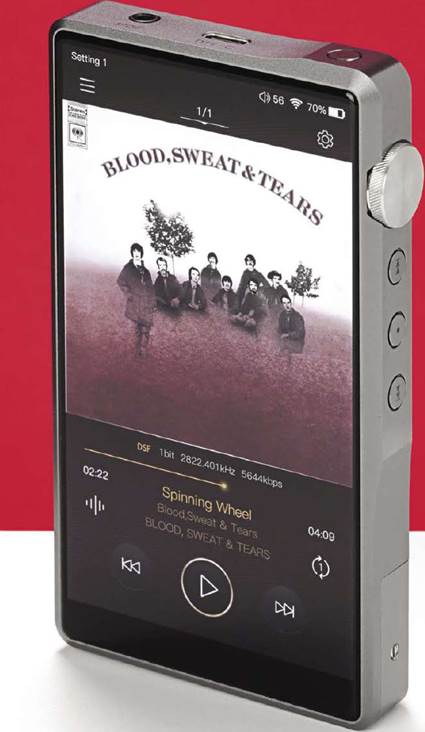COWON PLENUE D3 Review
It’s diddly small but sounds good. Noel Keywood enjoys Cowon’s D3 portable music player.
Astell&Kern’s AK100, which I reviewed in the March 2013 issue, could “fit in a shirt pocket”, sounded great and was affordable. Since then, portable digital players have grown in complexity and size; these days, you need a trouser pocket – a big one. Cowon’s new Plenue D3 is shirt pocket size and price.
Technology has moved on since 2013. The tiny Plenue has enough memory and processing power to play any file, even double-rate DSD (DSD128). The D3 has a useful 64GB of memory on-board that will handle 10 CDs or so, but a single microSD card slot accepts up to 128GB if you like DSD.

I find an external card slot useful for quickly changing the music library, and the Plenue D3 automatically reads a card when inserted to show its content immediately.
Popping in a 128GB card gives access to 100 (or so) DSD tracks, 2000 CD tracks, and more MP3s than are good for you.
Being a small player, the screen display of track menus is inevitably cramped, but the Plenue D3 has a touch screen that can be swiped up and down to scroll through long track lists quickly. I found that high-resolution text and plenty of contrast made reading the screen easy, and the touch screen is area-sensitive.
Small players, in particular, can be difficult to navigate, and here, the D3 was satisfactory, if not wonderful. The home screen is a long list of nine categories – folders, songs, genres, years, playlists, and all that – displayed by small icons. Not very appealing. However, folders and songs are there, and an SD card is seen as a folder.
A feature of this player is the presence of no fewer than 44 Cowon JetEffect 5 equalization settings, like Rock, Pop, Reverb Hall, Reverb Canyon, all the way to Feel The Wind. They can be dialed out by selecting Normal, and there are 4 User settings, too, where a 5-band equalizer can be adjusted to suit. ‘BBE’ they say, uses phase correction to “refine sound quality” and there are no fewer than eight eightettings in this category.
The top panel has a conventional 3.5mm stereo headphone socket (3-pole) and a smaller 2.5mm (4-pole) for a balanced connection to headphones. Sounds good, but this only splits the earth lead to each earpiece and doesn’t greatly improve the sound, I’ve found, tdownsideiising a tiny 2.5mm plug that breaks easily. Also, it’s near-impossible to make up a lead at home, as the plug contacts and protective sleeve are so small. Anyone wanting to use balanced on the move should look to a player with a 4.4mm Pentacon socket or mini-XLR; a 2.5mm will just survive at home when treated carefully. Alongside the sockets is a rotary volume control with colored LED to show status.

The Plenue checks into a Mac or PC with equal fluency; no little green Android loading man appears when plugging into a Mac, it is seen as a normal Flash Drive, not as an Android based player OS (which most are). This makes loading music files to internal memory an easy business, as well as deleting them if unwanted. It was also easy to upgrade the firmware, even on my Mac, where hidden desktop files were once a problem with Android.

Playing time with 24/96 files, but this will be with the screen off. On the test bench with a screen on continually, it was running down before my eyes on the battery indicator, and I would guess 6-8 hours would be the limit. Screen brightness and auto-off time affect this. It should be good for 15hrs or so just copy in two BIN files from Cowon’s website, switch off then on, and player updates automatically with clear indication that it has done so. Ours was running V1.0.
“The Crystal Semiconductor CS43131 DACs did a nice job, giving true hi-res clarity”

The player charges through a supplied USB A-USB C lead from the usual 5V ‘phone charger (not supplied), and Cowon claims a massive 30 hours in normal use. Bluetooth shortrange wireless linking is fitted, to feed music to a hi-fi or wireless headphones.
With dimensions of 53mm wide, 80mm high, and 17mm deep, this player is credit card size and will be stowed anywhere. A weight of 103gm makes it flyweight.
SOUND QUALITY
Why did I update the firmware on the PC and then on the Mac? Well, in truth, I did it twice because the Hearing Protection option listed in the User Manual was missing, and I hoped an update would restore it. An output of 2V is claimed – a common value – but our player measured 0.3V on both outputs (Headphone Output selected), which is about right for hearing protection.

I wound the volume up to 110 when listening, and after that, nothing happened all the way up to 140 (max).
I suspect Hearing Protection was switched on, something done to fall in line with legal requirements in some markets. Unfortunately, I use Oppo PM 1 planar magnetic headphones – and planar magnetics are insensitive. The Oppos ran loud, loud enough for me, but PMs of lower sensitivity need more output.



Also, the inability to switch protection off means the published spec isn’t being met, which is a potentially contentious issue. This setting needs to be restored in Firmware by Cowon. As it stands, however, the small Plenue still runs plenty loud enough for most people, especially those using earbuds.
The sound was easy and clear, if dynamically restrained – as is common with small players equipped with small batteries. Bass was there but not especially well-defined. That sent me to Cowon’s JetEffect, and indeed, some of the EQs usefully livened things up, such as BBE Headphone 2 and Rock and Feel The Wind, which gave a nice feel. The reverb settings were pointless. I suspect user settings will suit most listeners – there is little need for pre-sets. The digital filters had little appreciable effect. The internal Crystal Semiconductor CS43131 DACs did a nice job, giving true hi-res clarity from decent hi-res recordings and certainly from DSD.
CONCLUSION
If you want a small, unpretentious little player that has useful internal memory capacity for music, a microSD card port so music libraries can be enjoyed – let’s say Reggae on one card and Classical on another – plus the ability to deliver a clear, clean sound then the Plenue D3 is a good choice. For use with ear buds and reasonably sensitive dynamic headphones, it’ll give you hi-res in good form, something your ‘phone won’t manage. Those hoping to use magnetic planar headphones might want to look elsewhere, though, until Cowon provides an option to remove Hearing Protection.

MEASURED PERFORMANCE
The headphone output of this player is rated as 2V from the unbalanced 3.5mm output jack and 4V from the balanced 2.5mm but our sample measured 0.3V (Headphone) and almost certainly had Hearing Protection operating, the ability to switch this off as described in the User Manual being missing from the Settings menu. Both unbalanced and balanced outputs measured the same, with the high output Headphone option enabled.

EIAJ Dynamic Range measured a respectable 112dB with 24bit and likely would have been higher had full output been available from the headphone amplifier. This is still comparable with medium-quality hi-fi DACs, though, and sufficient for hi-res qualities to be apparent.
Similarly, distortion at -60dB was low with 24bit, measuring 0.07%, 16and bit (CD), measuring 0.26%.
The frequency response was extended to a high 85kHz with a 192kHz sample rate of PCM, as our analysis shows.
The Plenue D3 measured well within the limitations imposed by the low output of hearing protection, which could not be switched off. Possibly, this is to meet European safety regulations since Sony used to impose such a limit on this. NK
Frequency response (-1dB) 4Hz-85kHz
Distortion (24bit) %
0dB 0.0005
-60dB 0.07
Separation (1kHz) 108dB
Noise (IEC A) -110dB
Dynamic range (24bit) 112dB
Output 0.3V
EXCELLENT – extremely capable





